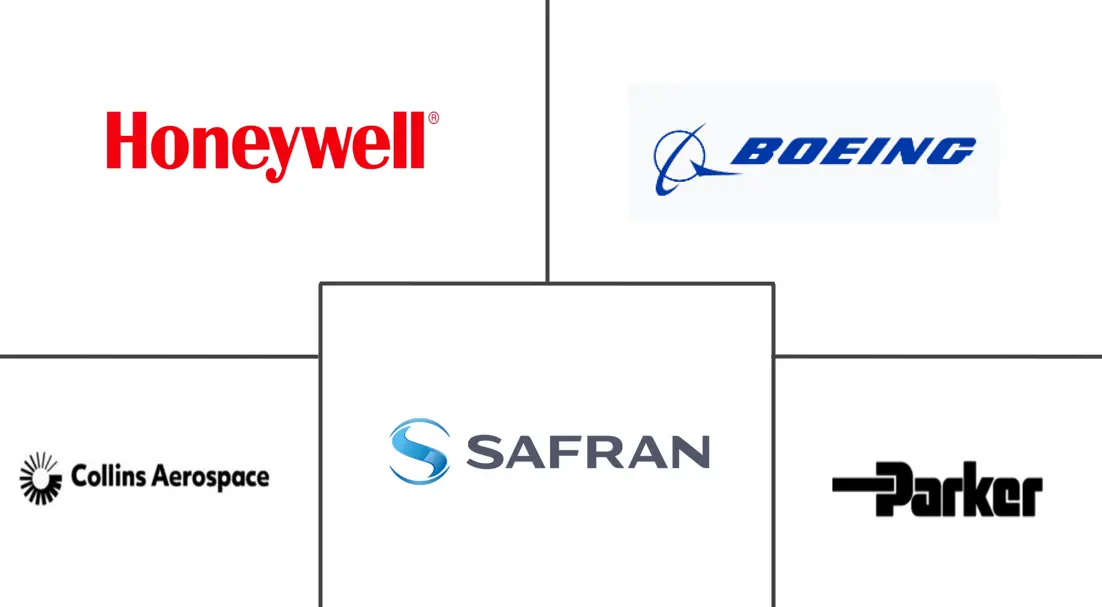Commercial Aircraft Carbon Brake Market Size and Share
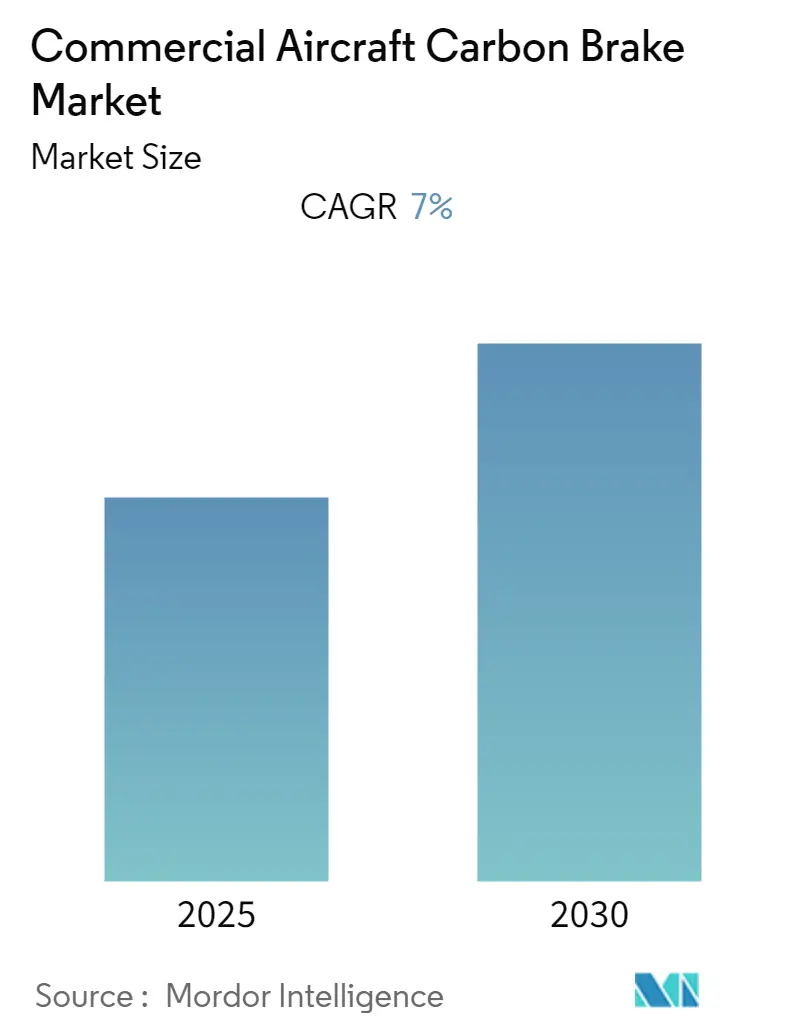
Commercial Aircraft Carbon Brake Market Analysis by Mordor Intelligence
The Commercial Aircraft Carbon Brake Market is expected to register a CAGR of 7% during the forecast period.
- The market for residential routers is currently experiencing a transformation as new bandwidth usage and service delivery scenarios are reshaping network infrastructures. To meet these changing demands, equipment manufacturers are developing carrier-class routers that offer a broader range of services and applications, support capacity scalability and have higher data rates. The market is highly fragmented, with many players involved, and it has the potential to grow further as manufacturers invest in innovative hardware and software features in their products. Some of the significant players offering services in this sector include D-Link Corporation, Netgear Inc., Linksys Group (Foxconn), Synology Inc., and others.
- In May 2022, the leading telecom equipment manufacturer, HFCL Limited, collaborated with Wipro to introduce 5G transport solutions. These solutions are designed to empower enterprises to realize their 5G-enabled vision and increase the speed with which they can bring high-quality 5G solutions to the market.
- In October 2022, MediaTek joined hands with Invendis to launch Made in India 5G Routers and Wi-Fi solutions. These routers would help consumers and enterprise customers provide secure, strong, and seamless wireless networking solutions.
- In February 2023, Telecom26 and Trasna Solutions partnered to develop eSIM management solutions for cellular routers. This solution allows router manufacturers to offer their customers an efficient and user-friendly way to manage their eSIMs on their existing SIM-based devices.
Global Commercial Aircraft Carbon Brake Market Trends and Insights
The Narrow Body Aircraft Segment Is Expected To Witness Significant Growth During The Forecast Period
- By aircraft type, the narrow-body aircraft segment is expected to witness significant growth during the forecast period. There has been an increase in the number of narrow-body aircraft deliveries worldwide. The International Air transport Association (IATA) report projected that there will be 24,285 units of narrowbody aircraft in use globally by 2032.
- The growth of narrow-body aircraft worldwide can be attributed to the increasing demand for air travel, rising passenger traffic, and the growing need for fuel-efficient aircraft. According to the data released by the IATA, each new generation of aircraft is, on average 20% more fuel-efficient than the model it replaces. This has meant that narrowbody planes have become particularly viable for long-distance routes. As of the present scenario, the A321 neo-narrow-body aircraft has been the game changer aircraft since the A321 neo is the most efficient narrow-body aircraft and will continue to remain the same in the coming few years.
- Furthermore, additional benefits associated with narrow-body aircraft, such as ease of operations as well as flight connectivity to various airports, make the narrow-body a more profitable aircraft to be operated by various aircraft operators worldwide.
- On the other hand, the rising growth of narrowbody aircraft can be attributed to its extensive usage by Low-Cost Carriers of LCCs since the LCCs are more focused on cost reduction by minimizing crew and maintaining a high operational efficiency through technological advancements in aircraft maintenance and operations. This trend is expected to drive demand for narrow-body aircraft with self-support applications across various regions worldwide.
- The rapid growth in air transportation has challenged the industry to find new solutions to the ongoing challenge of meeting passenger demand while delivering increased efficiency in a hugely competitive marketplace. This has led to the development of aircraft such as the Airbus A321neoLR and the Boeing 737 MAX. These narrowbody aircraft offer increased range and efficiency, which makes it possible for them to compete in a market that had previously been dominated by widebody jetliners. For instance, the A321LR has a range of 7,400 kilometers, while the 737 MAX is also capable of reaching similar distances.
- Thus, an increase in the demand for new and efficient narrow-body aircraft to cater to the rising world air passenger traffic and with narrowbody aircraft being viable to fly long routes will propel the segment to growth during the forecast period.
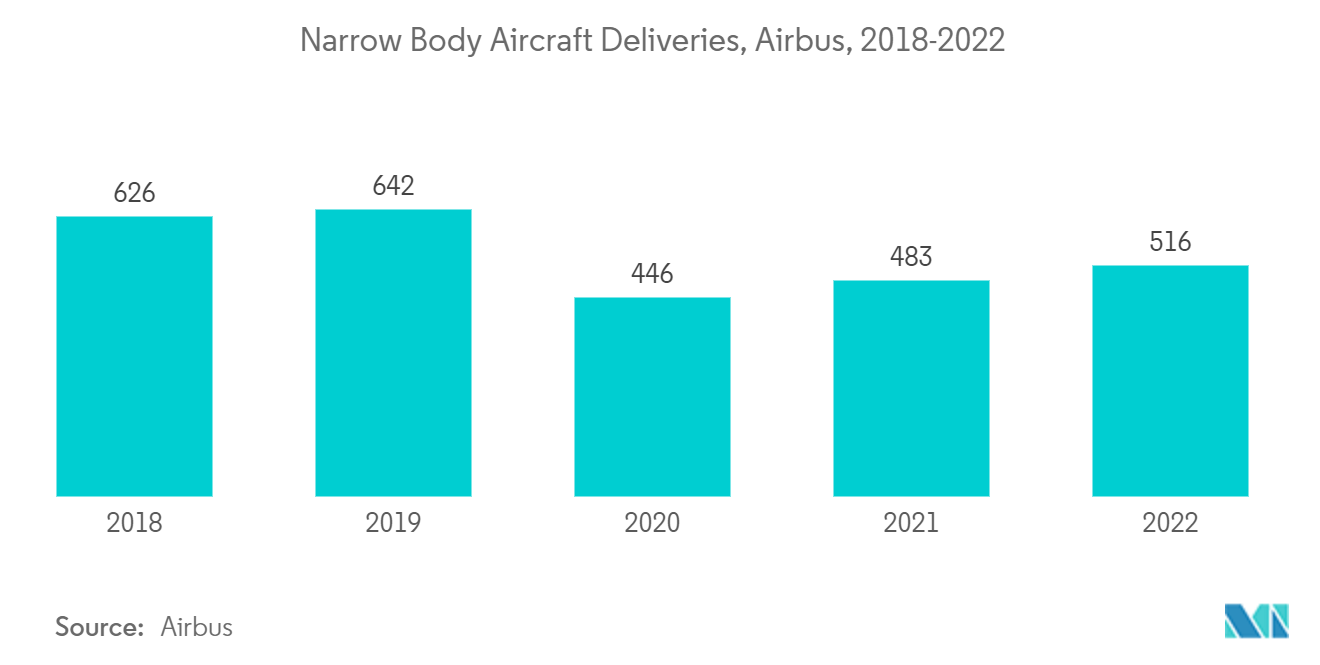
Asia-Pacific Region is Expected to Witness Significant Growth During The Forecast Period
- By aircraft type, the narrowbody aircraft segment is expected to witness significant growth during the forecast period. There has been an increase in the number of narrowbody aircraft deliveries worldwide. The International Air Transport Association (IATA) report projected that there will be 24,285 units of narrowbody aircraft in use globally by 2032.
- The growth of narrowbody aircraft worldwide can be attributed to the increasing demand for air travel, rising passenger traffic, and the growing need for fuel-efficient aircraft. According to the data released by the IATA, each new generation of aircraft is, on average, 20% more fuel-efficient than the model it replaces, and this has meant that narrowbody planes have become particularly viable for long-distance routes. As of the present scenario, the A321 neo-narrow-body aircraft has been the game changer aircraft since the A321 neo is the most efficient narrowbody aircraft and will continue to remain the same in the coming few years.
- Furthermore, additional benefits associated with narrowbody aircraft, such as ease of operations as well as flight connectivity to various airports, make the narrow body a more profitable aircraft to be operated by various aircraft operators worldwide. On the other hand, the rising growth of narrowbody aircraft can be attributed to its extensive usage by Low-Cost Carriers of LCCs since the LCCs are more focused on cost reduction by minimizing crew and maintaining a high operational efficiency through technological advancements in aircraft maintenance and operations. This trend is expected to drive demand for narrowbody aircraft with self-support applications across various regions worldwide.
- The rapid growth in air transportation has challenged the industry to find new solutions to the ongoing challenge of meeting passenger demand while delivering increased efficiency in a hugely competitive marketplace. This has led to the development of aircraft such as the Airbus A321neoLR and the Boeing 737 MAX. These narrowbody aircraft offer increased range and efficiency, which makes it possible for them to compete in a market that had previously been dominated by widebody jetliners. For instance, the A321LR has a range of 7,400 kilometers, while the 737 MAX is also capable of reaching similar distances.
- Thus, an increase in the demand for new and efficient narrowbody aircraft to cater to the rising world air passenger traffic and with narrowbody aircraft being viable to fly long routes will propel the segment to growth during the forecast period.
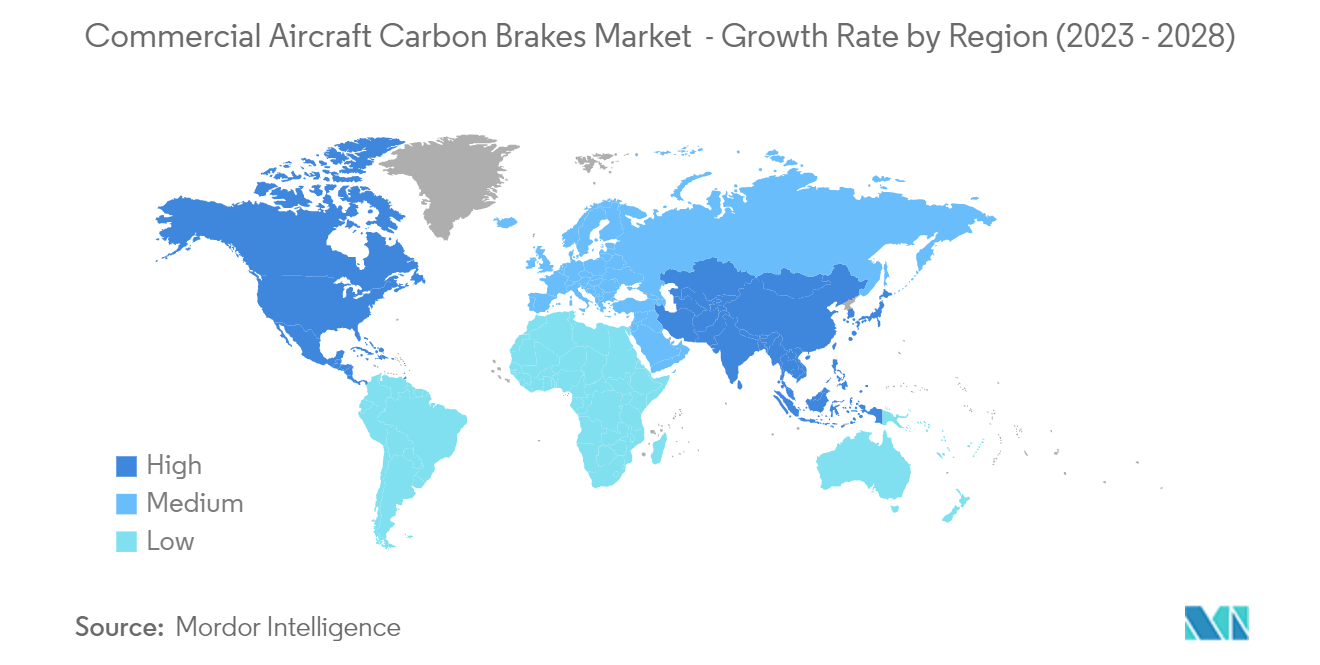
Competitive Landscape
The market is moderately fragmented in nature, with several players holding significant shares in the market. Some of the prominent players in the commercial aircraft carbon brake market are Honeywell International Inc., Boeing, Safran, Collins Aerospace, and Parker Hannifin Corp, amongst others. These companies have expanded their presence in various regions in order to provide flexible aircraft carbon brake systems manufacturing options facilitating cost-effective production and supply of such systems to the system integrators or aircraft OEMs and MROs. The market attractiveness is envisioned to increase as the growth of the market would be in line with the recovery of the global aviation industry, and demand for such systems would be generated from both OEM and MRO channels.
Commercial Aircraft Carbon Brake Industry Leaders
-
Honeywell International Inc.
-
Safran
-
Collins Aerospace
-
Parker Hannifin Corp
-
Boeing
- *Disclaimer: Major Players sorted in no particular order
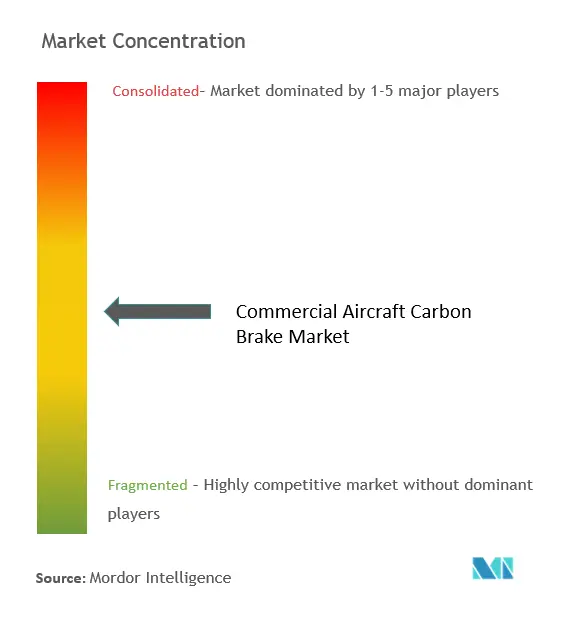
Recent Industry Developments
July 2021: Singapore Airlines (SIA) signed a contract with Safran Landing Systems to provide wheels and carbon brakes for its entire fleet of Boeing 777-9. Under the contract, all heat-sink exchanges would be performed by Safran Landing Systems' facility in Sendayan, Malaysia.
March 2022: Avelo Airlines and Collins Aerospace announced an agreement to retrofit Avelo's fleet of Boeing Next-Generation (NG) 737 aircraft with new wheels and carbon brakes. The agreement includes wheel and carbon brake maintenance services and logistics support for the new U.S. airline.
Global Commercial Aircraft Carbon Brake Market Report Scope
The aircraft brake system is generally used to slow down the aircraft during the landing roll on the runway. It is a necessary component to ensure the safety and directional control of an aircraft during ground operations, such as taxiing, landing, and takeoff. The carbon braking system provides anti-skid protection and fully integrated brake control, including emergency and parking brake functions, by merging brake-by-wire controlled technology with electro-mechanical brake actuation.
The commercial aircraft carbon brake market has been segmented by aircraft type (narrow-body aircraft, wide-body aircraft, and regional aircraft) and geography (North America, Europe, Asia-Pacific, Latin America, and the Middle East and Africa).
Moreover, the report offers a market forecast and is represented by USD million.
| Narrow-body Aircraft |
| Wide-body Aircraft |
| Regional Aircraft |
| North America | United States |
| Canada | |
| Europe | Germany |
| United Kingdom | |
| France | |
| Rest of Europe | |
| Asia-Pacific | China |
| India | |
| Japan | |
| South Korea | |
| Rest of Asia-Pacific | |
| Latin America | Brazil |
| Rest of Latin America | |
| Middle-East & Africa | United Arab Emirates |
| Saudi Arabia | |
| Isarel | |
| South Africa | |
| Rest of Middle East & Africa |
| Aircraft Type | Narrow-body Aircraft | |
| Wide-body Aircraft | ||
| Regional Aircraft | ||
| Geography | North America | United States |
| Canada | ||
| Europe | Germany | |
| United Kingdom | ||
| France | ||
| Rest of Europe | ||
| Asia-Pacific | China | |
| India | ||
| Japan | ||
| South Korea | ||
| Rest of Asia-Pacific | ||
| Latin America | Brazil | |
| Rest of Latin America | ||
| Middle-East & Africa | United Arab Emirates | |
| Saudi Arabia | ||
| Isarel | ||
| South Africa | ||
| Rest of Middle East & Africa | ||
Key Questions Answered in the Report
What is the current Commercial Aircraft Carbon Brake Market size?
The Commercial Aircraft Carbon Brake Market is projected to register a CAGR of 7% during the forecast period (2025-2030)
Who are the key players in Commercial Aircraft Carbon Brake Market?
Honeywell International Inc., Safran, Collins Aerospace, Parker Hannifin Corp and Boeing are the major companies operating in the Commercial Aircraft Carbon Brake Market.
Which is the fastest growing region in Commercial Aircraft Carbon Brake Market?
Asia Pacific is estimated to grow at the highest CAGR over the forecast period (2025-2030).
Which region has the biggest share in Commercial Aircraft Carbon Brake Market?
In 2025, the North America accounts for the largest market share in Commercial Aircraft Carbon Brake Market.
What years does this Commercial Aircraft Carbon Brake Market cover?
The report covers the Commercial Aircraft Carbon Brake Market historical market size for years: 2019, 2020, 2021, 2022, 2023 and 2024. The report also forecasts the Commercial Aircraft Carbon Brake Market size for years: 2025, 2026, 2027, 2028, 2029 and 2030.
Page last updated on:
Commercial Aircraft Carbon Brake Market Report
Statistics for the 2025 Commercial Aircraft Carbon Brake market share, size and revenue growth rate, created by Mordor Intelligence™ Industry Reports. Commercial Aircraft Carbon Brake analysis includes a market forecast outlook for 2025 to 2030 and historical overview. Get a sample of this industry analysis as a free report PDF download.
